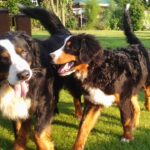Dealing with an aggressive dog can be a daunting task, especially when it comes to socialization. Whether it’s fear, territorial behavior, or a lack of early social experiences, understanding the root of aggression is key to overcoming it. In this guide, we’ll explore effective strategies to help your canine companion become more comfortable and friendly around other dogs and people. Discover how patience, consistency, and the right approach can transform your aggressive dog into a sociable pet. Ready to embark on this journey? Let’s dive in.
Understanding Your Dog’s Aggression
Comprehending the root causes of your dog’s aggression is pivotal in formulating a successful socialization and training plan. Aggression in dogs can stem from a variety of sources such as fear, territorial behavior, possessiveness, pain, or even past trauma. Recognizing the specific triggers that provoke your dog’s aggressive responses is the first step toward addressing and modifying this behavior. It’s essential to observe your dog in different situations to identify patterns or consistent triggers of their aggression.
Consulting with a professional animal behaviorist can be incredibly beneficial. These experts can offer insights and strategies tailored to your dog’s needs, ensuring that you approach their aggression with understanding and patience. It’s crucial to remember that aggression is often a symptom of underlying issues such as anxiety or insecurity. Therefore, punishment is not only ineffective but can exacerbate the problem, making your dog more fearful or aggressive.
Building a foundation of trust and safety is key. This involves creating positive associations with situations or stimuli that currently trigger your dog’s aggression. Through gradual exposure and rewards for calm behavior, your dog can learn to respond differently. Remember, the goal is to reduce their stress and anxiety, fostering a more relaxed and sociable demeanor.
Additional Insights on Canine Aggression
It’s important to acknowledge that not all aggression can be fully eliminated, especially in cases of deep-seated fears or traumatic past experiences. However, with consistent and compassionate training, many dogs can learn to manage their aggression significantly. This journey requires patience, understanding, and often professional guidance, but the result—a harmonious and safe relationship—is well worth the effort.
| Type of Aggression | Common Triggers | Possible Solutions |
|---|---|---|
| Fear-based | Strangers, Loud Noises | Gradual Desensitization |
| Territorial | Protecting Property | Boundary Training |
| Possessive | Food, Toys | Resource Guarding Training |
| Pain-induced | Handling, Touch | Medical Evaluation, Desensitization |
| Social | Other Dogs, People | Socialization Exercises |
Establishing Trust and Safety
When it comes to socializing an aggressive dog, the cornerstone of any successful transformation is establishing trust and safety. This is not just about physical safety, but also about creating an environment where your dog feels secure and understood. The goal is to build a strong foundation of trust, so your pet knows you are their ally, capable of guiding them through their fears and reactions without judgment or punishment.
One of the first steps in this process involves consistent, positive interactions. Dogs, much like humans, thrive on consistency as it helps them understand what is expected of them. By setting clear, consistent boundaries, you provide your dog with a structured environment where they can learn and grow. Positive reinforcement techniques, such as treats and praise, should be employed to reward desired behaviors, reinforcing the idea that compliance leads to good things. Avoid using harsh discipline, as it can erode trust and exacerbate aggressive tendencies.
Understanding your dog’s body language is also crucial. It allows you to recognize signs of discomfort or stress early on, enabling you to address these feelings before they escalate into aggression. Remember, socialization is not just about exposing your dog to new people and animals; it’s about doing so in a way that ensures they feel safe and supported throughout the experience.
Key Strategies for Building Trust
| Strategy | Description | Benefits |
|---|---|---|
| Consistent Routines | Establishing a predictable daily routine. | Reduces anxiety, builds confidence. |
| Positive Reinforcement | Using treats and praise to encourage good behavior. | Strengthens bond, encourages compliance. |
| Understanding Body Language | Learning to read your dog’s non-verbal cues. | Prevents escalation of aggression, builds empathy. |
| Controlled Socialization | Gradually introducing new people and animals. | Improves behavior in social settings. |
| Safe Spaces | Creating a dedicated area where your dog feels secure. | Provides a retreat, reduces stress. |
By focusing on these strategies, you can make significant strides in transforming your aggressive dog into a well-socialized companion. Remember, patience and consistency are key. Every dog has the potential to overcome their fears and thrive in a social environment, provided they have the right support and guidance.
Gradual Exposure to Social Situations
Socializing an aggressive dog is a delicate process that requires patience, understanding, and a strategic approach. One of the most effective strategies is to gradually expose your dog to various social situations, thereby allowing them to become comfortable and confident in a controlled manner. This process begins in environments where your dog feels safe and can observe from a distance without direct interaction. Over time, you can slowly decrease this distance as your dog starts showing signs of comfort and decreased aggression.
It’s essential to monitor your dog’s reactions closely during this process. Signs of stress or discomfort mean it’s time to take a step back and slow down the exposure. Positive reinforcement plays a crucial role here; rewarding your dog for calm and non-aggressive behavior in the presence of other dogs or people will reinforce that this is the desired response. Remember, the goal is not to overwhelm your dog but to build its confidence gradually.
Incorporating structured activities into the socialization process can also be beneficial. Activities that require your dog to focus on tasks or commands can help redirect their attention away from the stress of the social situation and towards something they are familiar with and confident in doing. This dual focus not only aids in reducing immediate stress responses but also builds a foundation of obedience and trust that is critical for long-term socialization success.
| Week | Activity | Goal |
|---|---|---|
| 1 | Watch dogs at a park from a distance | Introduction to external stimuli |
| 2 | Short walks in quiet areas | Gradual exposure to outdoor environments |
| 3 | Introduction to a calm, friendly dog | Direct but controlled social interaction |
| 4 | Visit pet-friendly stores | Exposure to different environments and people |
| 5 | Enroll in a group training class | Structured socialization and obedience training |
Implementing Positive Reinforcement Techniques
Transforming an aggressive dog into a sociable pet requires patience, understanding, and the right approach. Among the most effective methods is the implementation of positive reinforcement techniques. This strategy revolves around rewarding desired behaviors, which encourages the dog to repeat them. Unlike punitive measures, which can exacerbate aggression, positive reinforcement fosters a trusting relationship between you and your pet.
At the heart of positive reinforcement is the timing of the reward. It’s crucial that the reward immediately follows the desired behavior, as this helps the dog associate the action with the positive outcome. Treats, praise, or playtime can serve as effective rewards, depending on what motivates your dog the most. Consistency is also key; every time your dog exhibits the desired behavior, they should receive the same positive feedback. This consistency helps reinforce the learning process.
However, it’s important to gradually introduce your dog to new situations and people, avoiding any overwhelming scenarios that could trigger aggression. Begin in a quiet, controlled environment and slowly increase the level of exposure as your dog becomes more comfortable. This method, known as desensitization, can be particularly effective when combined with positive reinforcement, as it allows the dog to associate new experiences with positive outcomes.
- Identify what motivates your dog (e.g., treats, praise, toys).
- Immediately reward desired behaviors to reinforce the association.
- Maintain consistency with rewards to solidify learning.
- Gradually introduce new people and environments to avoid overwhelming your pet.
- Combine desensitization techniques with positive reinforcement for the best results.
Further Insights on Positive Reinforcement
Delving deeper into the nuances of positive reinforcement, it’s essential to understand the role of patience and adaptation. Each dog is unique, with its own set of fears, motivations, and behaviors. What works for one dog might not work for another, requiring you to be observant and flexible in your approach. Tailoring the reinforcement to your dog’s individual needs can significantly enhance the effectiveness of your training efforts, leading to a more harmonious and happy relationship with your pet.
Seeking Professional Help and Training
Facing the challenge of socializing an aggressive dog can be daunting and, at times, may seem insurmountable. However, the assistance of a professional trainer or behaviorist can transform this journey into a manageable and educational experience. These experts are skilled in understanding the nuances of canine behavior, and they possess the tools and techniques necessary to address aggression in dogs effectively. It’s crucial to recognize that early intervention is key to preventing the escalation of aggressive behaviors.
Choosing the right professional is paramount. Look for individuals with a solid track record, who employ positive reinforcement methods, and who are certified by reputable organizations. A professional can assess your dog’s behavior in a holistic manner, considering factors such as environment, genetics, and past experiences. This comprehensive approach ensures that the training plan is tailored to your dog’s specific needs, increasing the likelihood of success.
Additionally, professional help doesn’t just benefit your dog; it’s also an educational opportunity for you as the owner. You’ll learn about the importance of consistency, the power of patience, and how to communicate with your pet in a way that fosters trust and respect. This knowledge is invaluable, as it empowers you to continue guiding your dog towards more sociable behavior long after the training sessions have ended.
Further Insights into Professional Training
Engaging with a professional trainer or behaviorist is not just about correcting unwanted behavior; it’s about building a stronger, more harmonious relationship between you and your pet. They can provide insights into your dog’s body language and stress signals, helping you to understand and respond to your dog’s needs proactively. This deeper understanding can significantly improve your dog’s quality of life and enhance the bond you share.
Deepening the Bond Through Understanding
Training sessions often reveal the underlying causes of aggression, such as fear or anxiety, and by addressing these root issues, you not only mitigate the aggressive behavior but also improve your dog’s overall well-being. This process is deeply rewarding, as it leads to a happier, more balanced pet, and a more confident, knowledgeable owner.
- Identify the underlying causes of aggression.
- Choose a professional with a positive reinforcement approach.
- Engage in consistent, ongoing training and follow-up sessions.
- Educate yourself on canine body language and stress signals.
- Build a stronger, more understanding relationship with your pet.
In conclusion, seeking the assistance of a professional trainer or behaviorist is a crucial step towards socializing an aggressive dog. It not only helps in modifying your pet’s behavior but also enhances your ability to communicate with and understand your furry friend. Remember, the journey towards transforming your pet into a sociable companion is a collaborative effort that requires patience, commitment, and the right professional guidance.




